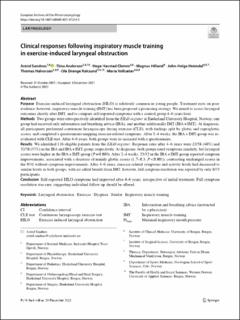| dc.contributor.author | Sandnes, Astrid | |
| dc.contributor.author | Andersen, Tiina Maarit | |
| dc.contributor.author | Clemm, Hege Synnøve Havstad | |
| dc.contributor.author | Hilland, Magnus | |
| dc.contributor.author | Heimdal, John-Helge | |
| dc.contributor.author | Halvorsen, Thomas | |
| dc.contributor.author | Røksund, Ola Drange | |
| dc.contributor.author | Vollsæter, Maria | |
| dc.date.accessioned | 2022-01-20T08:34:42Z | |
| dc.date.available | 2022-01-20T08:34:42Z | |
| dc.date.created | 2022-01-06T16:52:10Z | |
| dc.date.issued | 2021 | |
| dc.identifier.issn | 0937-4477 | |
| dc.identifier.uri | https://hdl.handle.net/11250/2838394 | |
| dc.description.abstract | Purpose
Exercise-induced laryngeal obstruction (EILO) is relatively common in young people. Treatment rests on poor evidence; however, inspiratory muscle training (IMT) has been proposed a promising strategy. We aimed to assess laryngeal outcomes shortly after IMT, and to compare self-reported symptoms with a control group 4–6 years later.
Methods
Two groups were retrospectively identified from the EILO-register at Haukeland University Hospital, Norway; one group had received only information and breathing advice (IBA), and another additionally IMT (IBA + IMT). At diagnosis, all participants performed continuous laryngoscopy during exercise (CLE), with findings split by glottic and supraglottic scores, and completed a questionnaire mapping exercise-related symptoms. After 2–4 weeks, the IBA + IMT-group was re-evaluated with CLE-test. After 4–6 years, both groups were re-assessed with a questionnaire.
Results
We identified 116 eligible patients from the EILO-register. Response rates after 4–6 years were 23/58 (40%) and 32/58 (55%) in the IBA and IBA + IMT-group, respectively. At diagnosis, both groups rated symptoms similarly, but laryngeal scores were higher in the IBA + IMT-group (P = 0.003). After 2–4 weeks, 23/32 in the IBA + IMT-group reported symptom improvements, associated with a decrease of mainly glottic scores (1.7–0.3; P < 0.001), contrasting unchanged scores in the 9/32 without symptom improvements. After 4–6 years, exercise-related symptoms and activity levels had decreased to similar levels in both groups, with no added benefit from IMT; however, full symptom resolution was reported by only 8/55 participants.
Conclusion
Self-reported EILO symptoms had improved after 4–6 years, irrespective of initial treatment. Full symptom resolution was rare, suggesting individual follow-up should be offered. | en_US |
| dc.language.iso | eng | en_US |
| dc.publisher | Springer | en_US |
| dc.relation.uri | https://link.springer.com/content/pdf/10.1007/s00405-021-07214-5.pdf | |
| dc.rights | Navngivelse 4.0 Internasjonal | * |
| dc.rights.uri | http://creativecommons.org/licenses/by/4.0/deed.no | * |
| dc.title | Clinical responses following inspiratory muscle training in exercise-induced laryngeal obstruction | en_US |
| dc.type | Journal article | en_US |
| dc.type | Peer reviewed | en_US |
| dc.description.version | publishedVersion | en_US |
| dc.rights.holder | Copyright The Author(s) 2021 | en_US |
| cristin.ispublished | true | |
| cristin.fulltext | original | |
| cristin.qualitycode | 1 | |
| dc.identifier.doi | 10.1007/s00405-021-07214-5 | |
| dc.identifier.cristin | 1976155 | |
| dc.source.journal | European Archives of Oto-Rhino-Laryngology | en_US |
| dc.identifier.citation | European Archives of Oto-Rhino-Laryngology, 2021. | en_US |

